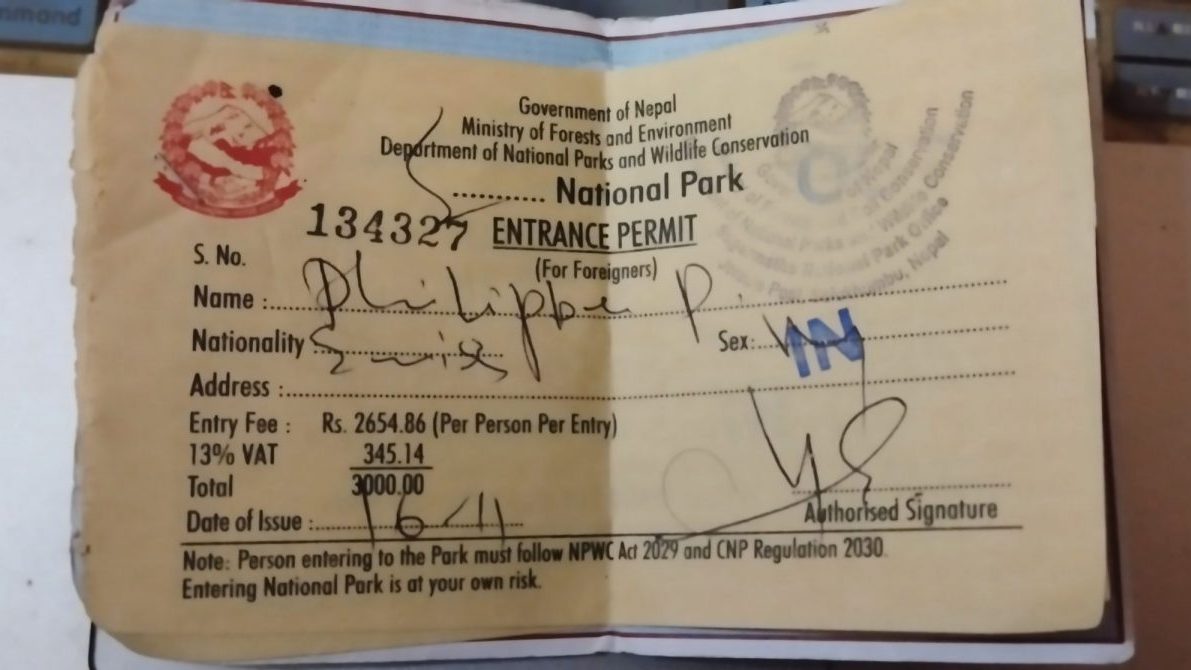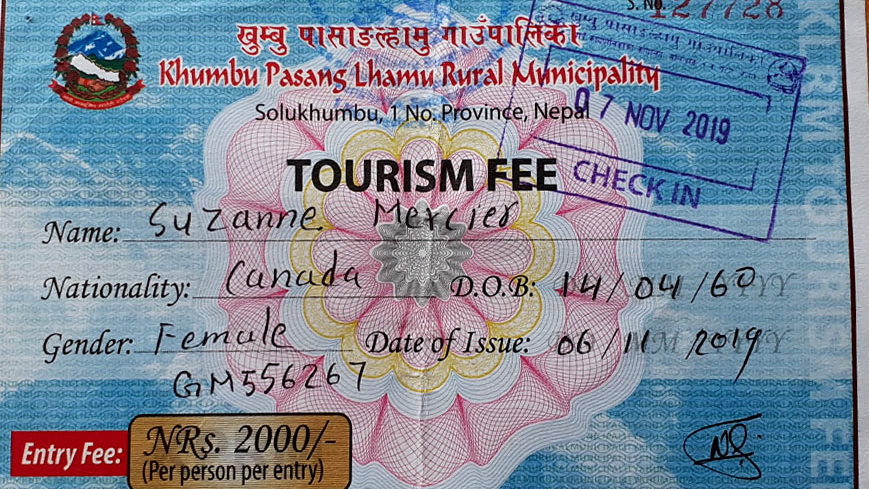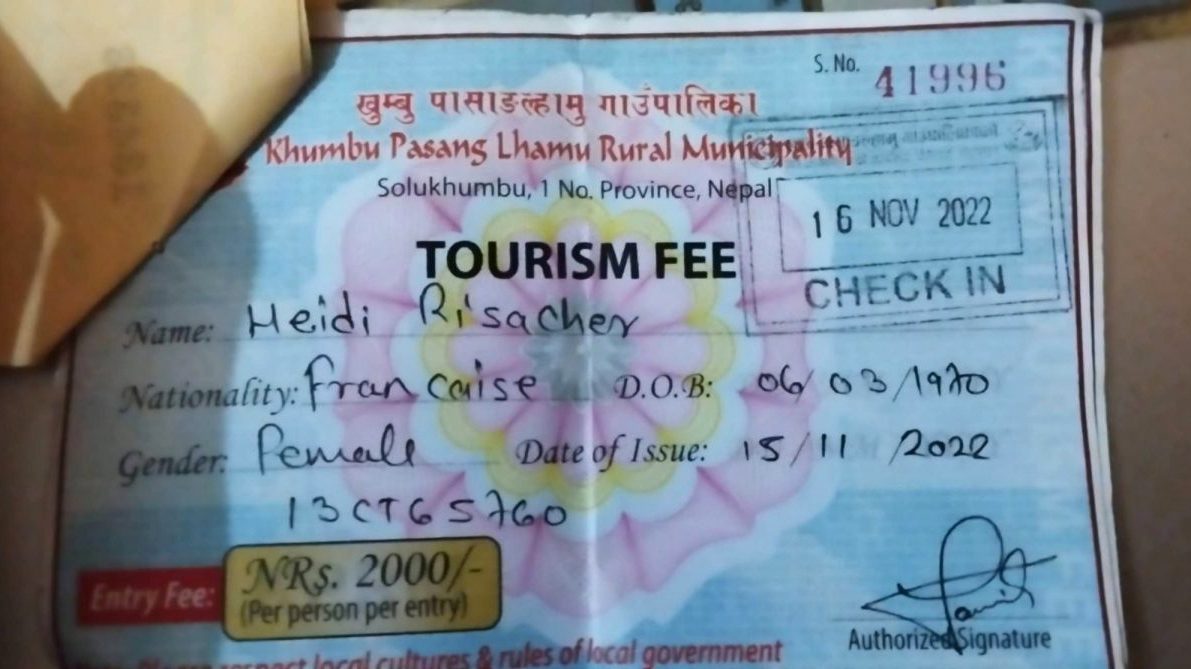Trekking to the renowned Everest Region is a once-in-a-lifetime trip, delivering spectacular scenery and a view into the heart of the Himalayas. before setting foot on the trails leading to the world's highest peaks, trekkers must navigate the essential yet often complex process of securing the necessary permits. Understanding the permit requirements is crucial for anyone planning this journey, as these permits are vital for conservation efforts and supporting local communities. This guide aims to simplify the permit acquisition process, detailing the Everest Base Camp trek permit requirements, the Sagarmatha National Park entry fee, the Khumbu Pasang Lhamu Rural Municipality permit, and the optional Gaurishankar Conservation Area permit. Additionally, it addresses the trekking permits for Nepal foreigners, how to obtain Everest trekking permits through the Nepal Tourism Board, permit checkpoints on the Everest trek and the cost of Everest Region trekking permits. With this information, trekkers can fully prepare for their journey, ensuring a seamless and enriching experience in the Everest Region.
We take pride in being the premier choice for adventurers seeking to explore the Everest Region. Our deep understanding of the intricacies involved in obtaining the necessary permits for Everest Region trekking sets us apart. We are not just a travel agency; we are your dedicated partners in adventure, ensuring that every detail of your trekking permit process is handled with utmost care and professionalism. Our team of experts works tirelessly to stay updated with the latest regulations and requirements, ensuring a hassle-free experience for our clients. From the Sagarmatha National Park entry fee to the Khumbu Pasang Lhamu Rural Municipality permit, and even the optional Gaurishankar Conservation Area permit, we manage it all so that you can focus on the thrill of the trek. Our close collaboration with the Nepal Tourism Board and our commitment to making the permit acquisition as smooth as possible underscore our dedication to providing an unparalleled service. For those looking to embark on the journey of a lifetime to the Everest Region, Luxury Holidays Nepal stands as the best company, promising not just a trek, but an unforgettable adventure, meticulously planned and seamlessly executed.
Sagarmatha National Park Entry Permit
Sagarmatha National Park, a UNESCO World Heritage Site, is a jewel in the crown of Nepal's natural heritage, especially for those embarking on the Everest Region trekking journey. To enter this pristine area, trekkers are required to obtain a Sagarmatha National Park Entry Permit. This permit is a fundamental requirement, underscoring the commitment of both trekkers and authorities to the conservation of the park's unique biodiversity and the promotion of sustainable tourism practices. Luxury Holidays Nepal ensures that obtaining this permit is a seamless process for our clients, allowing them to focus on the exhilarating experience of trekking in the shadows of the world's highest peaks.

-
Mandatory for Entry: The permit is essential for anyone looking to trek in the Everest Region, providing access to the park and its myriad of trails.
-
Contribution to Conservation: The fees collected from the permit go directly towards conservation efforts within Sagarmatha National Park, including flora and fauna protection, trail maintenance, and local community support.
-
Acquisition Process: While trekkers can obtain the permit at the Nepal Tourism Board office in Kathmandu or at entry points in the Everest Region, Luxury Holidays Nepal can facilitate this process, ensuring all paperwork is prepared accurately and efficiently.
-
Cost: The cost of the permit is subject to change, but it is crucial to budget for this expense as part of your trekking preparation. The fee contributes significantly to the maintenance and conservation efforts of the park.
-
Regulatory Compliance: Holding this permit ensures trekkers are compliant with local regulations, supporting responsible tourism and the preservation of Nepal’s natural and cultural heritage.
Securing a Sagarmatha National Park Entry Permit is not just a regulatory requirement but a meaningful contribution to the preservation of one of the world's most spectacular natural landscapes. Luxury Holidays Nepal is dedicated to making the process as straightforward as possible, ensuring trekkers can immerse themselves in the beauty of the Himalayas with peace of mind.
Khumbu Pasang Lhamu Rural Municipality Permit
For trekkers venturing into the heart of the Himalayas, particularly the Everest Region, acquiring the Khumbu Pasang Lhamu Rural Municipality Permit is a critical step. This permit is distinct from the Sagarmatha National Park Entry Permit and is specifically required for access to areas within the Khumbu Pasang Lhamu Rural Municipality, which includes the gateways to Everest Base Camp and other significant trekking routes in the region.

-
Purpose and Contribution: The permit fees are utilized directly by the local municipality for sustainable development projects within the Khumbu region. These initiatives range from infrastructure development, such as trail maintenance and waste management, to supporting educational and healthcare services for the local Sherpa community.
-
Requirement for All Trekkers: Every trekker, regardless of their nationality, is required to obtain this permit to trek in the Khumbu region. It's a necessary document for entering and traveling within the area.
-
Obtaining the Permit: Unlike some other permits, the Khumbu Pasang Lhamu Rural Municipality Permit cannot be obtained in Kathmandu. It is exclusively available at various checkpoints within the Khumbu region itself, such as Lukla and Monjo.
-
Cost: The cost of the permit is fixed and is directly paid to the local municipality. This fee remains consistent throughout the year, unlike some permits which may vary seasonally.
-
No Double Regulation: It's important to note that trekkers do not need a TIMS (Trekkers' Information Management System) card if they have the Khumbu Pasang Lhamu Rural Municipality Permit. This streamlines the permit process for trekkers in this region.
At Luxury Holidays Nepal, we understand the importance of supporting local communities while ensuring our clients have a hassle-free experience obtaining all necessary permits. Our team is equipped to provide you with the latest information and assist you in navigating the permit process smoothly, allowing you to focus on the breathtaking landscapes and rich cultural experiences that await you in the Everest Region.
Optional Gaurishankar Conservation Area Permit
For adventurers whose journey extends into the captivating landscapes of the Gaurishankar Conservation Area, obtaining the Optional Gaurishankar Conservation Area Permit becomes an essential part of the trekking preparations. This permit is specifically designed for trekkers traversing through this conservation area, which is known for its diverse ecosystems and the majestic Gaurishankar Mountain, considered sacred by the local communities.
-
Purpose of the Permit: The permit serves a dual purpose: it aids in the conservation efforts of the Gaurishankar Conservation Area and ensures the sustainable development of the region. The funds collected from the permit fees contribute to preserving the area's unique biodiversity and supporting local communities.
-
Who Needs This Permit?: This permit is required for trekkers who plan to explore routes that pass through the Gaurishankar Conservation Area, which is adjacent to the Everest Region. It's particularly relevant for those undertaking treks that cross over into this area, such as parts of the Rolwaling trek or treks that combine the Everest Region with other areas.
-
Acquiring the Permit: Trekkers can obtain the Gaurishankar Conservation Area Permit in Kathmandu at the Department of National Parks and Wildlife Conservation or at designated checkpoints on the way to the conservation area. This flexibility ensures that trekkers can secure their permits without significant detours or delays.
-
Cost of the Permit: The permit fee is set by the Nepalese government and is subject to change. It's essential for trekkers to verify the current cost before their journey to budget accordingly. The fee is a direct contribution to the conservation and sustainable development initiatives within the Gaurishankar Conservation Area.
-
No Overlap with Other Permits: It's important to note that this permit is separate from the Sagarmatha National Park Entry Permit and the Khumbu Pasang Lhamu Rural Municipality Permit. Trekkers need to obtain it in addition to other required permits if their route goes through the Gaurishankar Conservation Area.
Luxury Holidays Nepal is committed to ensuring that our clients are well-informed and fully prepared for their trekking adventures. We assist in navigating the complexities of the permit process, including the acquisition of the Optional Gaurishankar Conservation Area Permit, allowing you to focus on the breathtaking experiences that await in the Himalayas. Our expertise ensures that your journey is not just a trek but a contribution to the preservation of Nepal's natural beauty and cultural heritage.
Importance of Permits
The importance of obtaining the necessary permits for Everest Region trekking cannot be overstated. These permits are not merely formalities; they are critical components of a regulatory framework designed to protect the unique environments of the Himalayas, support local communities, and ensure a sustainable and responsible trekking industry. Here are the key reasons why permits are vital for trekking in the Everest Region:

Conservation and Environmental Protection
- Sagarmatha National Park Entry Permit and the Optional Gaurishankar Conservation Area Permit contribute directly to the conservation efforts of these protected areas. The fees collected help fund biodiversity preservation, trail maintenance, and waste management initiatives, ensuring that the natural beauty and ecological balance of the region are maintained for future generations.
Community Support and Development
- The Khumbu Pasang Lhamu Rural Municipality Permit directly supports local infrastructure projects, healthcare, and education within the Khumbu community. By obtaining this permit, trekkers contribute to the well-being and development of the local Sherpa communities that make the Everest Region trekking experience possible.
Regulatory Compliance and Trekker Safety
- Permits help regulate the flow of tourists, reducing environmental impact and ensuring that the region can accommodate visitors without compromising safety or sustainability. They also assist in managing trekker safety, as the permit system helps keep track of who is in the area in case of emergencies.
Promoting Responsible Trekking Practices
- By adhering to the permit requirements, trekkers demonstrate a commitment to responsible tourism. This includes following established trails, respecting wildlife and natural resources, and engaging with local cultures in a respectful and sustainable manner.
Facilitating Quality Trekking Experiences
- The permit system supports the infrastructure that makes trekking in the Everest Region accessible and enjoyable. This includes well-maintained trails, conservation efforts, and the availability of local guides and porters, enhancing the overall trekking experience.
At Luxury Holidays Nepal, we understand the significance of these permits and are committed to facilitating a smooth permit acquisition process for our clients. Our expertise not only ensures compliance with all regulatory requirements but also supports the broader goals of conservation, community support, and responsible tourism. By choosing to trek with us, you contribute to a sustainable future for the Everest Region and enjoy a more meaningful and enriching trekking experience.
The permit requirements for Everest Region trekking is a vital step in planning your Himalayan adventure. These permits—the Sagarmatha National Park Entry Permit, Khumbu Pasang Lhamu Rural Municipality Permit, and the Optional Gaurishankar Conservation Area Permit—serve not just as your entry ticket to some of the world's most breathtaking landscapes but also as a testament to your commitment to responsible trekking practices. By obtaining these permits, trekkers contribute to the conservation of the region's unique biodiversity, support local communities, and ensure a sustainable future for trekking in Nepal. Luxury Holidays Nepal is dedicated to ensuring that this process is seamless for our clients, allowing them to focus on the exhilarating experience that awaits in the Everest Region, all while upholding the values of conservation and community support.
FAQs: Permits for Everest Region Trekking
Q: What permits do I need for Everest Region trekking?
A: For trekking in the Everest Region, you typically need the Sagarmatha National Park Entry Permit, the Khumbu Pasang Lhamu Rural Municipality Permit, and depending on your route, the Optional Gaurishankar Conservation Area Permit.
Q: Can I obtain these permits upon arrival in Nepal?
A: The Sagarmatha National Park Entry Permit and the Optional Gaurishankar Conservation Area Permit can be obtained in Kathmandu at the Department of National Parks and Wildlife Conservation or at entry points in the park. The Khumbu Pasang Lhamu Rural Municipality Permit must be obtained within the Khumbu region itself, at designated checkpoints.
Q: How much do the permits cost?
A: Costs can vary, but as of the last update, the Sagarmatha National Park Entry Permit is approximately USD 30, the Khumbu Pasang Lhamu Rural Municipality Permit is around USD 20, and the Optional Gaurishankar Conservation Area Permit also costs about USD 20. It's best to check for the most current prices as they can change.
Q: Why are these permits necessary?
A: These permits are essential for conservation efforts, maintaining and protecting the trails, supporting local communities, and ensuring that trekkers contribute to the sustainable development of the region. They also help manage the number of visitors to prevent overcrowding and preserve the natural environment.
Q: Can Luxury Holidays Nepal assist me in obtaining these permits?
A: Yes, Luxury Holidays Nepal can facilitate the entire permit process for you. We ensure all necessary permits are obtained efficiently and accurately, allowing you to focus on preparing for your trek without the hassle of paperwork.
Q: What happens if I trek without the required permits?
A: Trekking without the required permits is illegal and can result in fines or being denied entry into certain areas. It's crucial to obtain all necessary permits to avoid any complications during your journey.
Q: Can I use these permits multiple times, or do I need new ones for each trek?
A: Permits are generally issued for a single trek and are date-specific. If you plan to return for another trek, you will need to obtain new permits for each visit.
If you need any further information, please contact us by email: at [email protected], Phone: +977- 985 100 5129 (WhatsApp)




